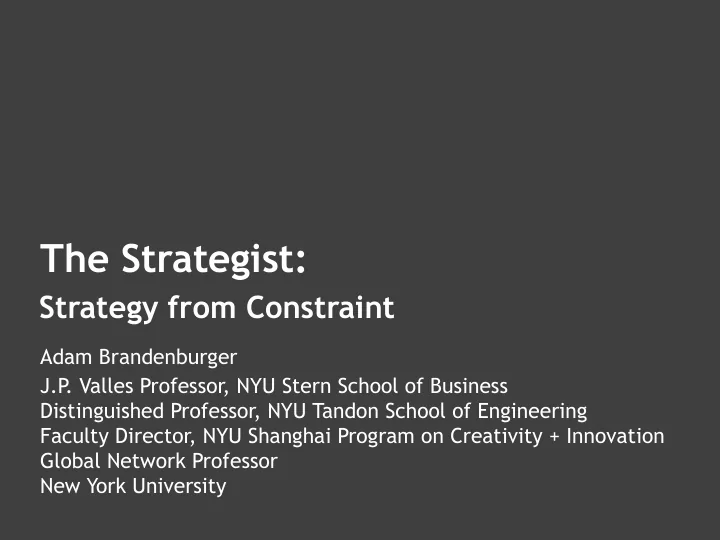

The Strategist: Strategy from Constraint Adam Brandenburger J.P . Valles Professor, NYU Stern School of Business Distinguished Professor, NYU Tandon School of Engineering Faculty Director, NYU Shanghai Program on Creativity + Innovation Global Network Professor New York University
https://www.youtube.com/watch?v=AFa1-kciCb4 Because budget strictures limited Morricone’s access to a full orchestra, he used gunshots, cracking whips, whistle, voices, guimbarde (jaw harp), trumpets, and the new Fender electric guitar, instead of orchestral arrangements of Western standards à la John Ford http://en.wikipedia.org/wiki/Ennio_Morricone; image from http://www.ifccenter.com/films/the-good-the-bad-and-the-ugly/ 2
“Strategy Needs Creativity” Adam Brandenburger Harvard Business Review , March-April 2019 Constraint — how to begin? List the “incompetencies” (rather than the competencies) of your organization — and test whether they can in fact be turned into strengths Consider deliberately imposing some constraints to encourage people to find new ways of thinking and acting Constraint — what to watch our for? Successful businesses face few obvious constraints; people may feel no need to explore how new ones might create new opportunities 3
Strengths Weaknesses of self of self c c Internal Internal Strengths Weaknesses Threats Opportunities External External Threats Opportunities c c Weaknesses Strengths of others of others 4
Strengths Weaknesses of self of self Which is which? c c Strategy from constraint Threats Opportunities Core rigidities Judo strategy c c Disruptive innovation Weaknesses Strengths Dorothy Leonard-Barton, “Core Capabilities and Core of others of others Rigidities: A Paradox in Managing New Product Development,” Strategic Management Review , 13, 1992, 118; Judith Gelman and Steven Salop, “Judo Economics: Capacity Limitation and Coupon Competition,” The Bell Journal of Economics , 14, 1983, 315-325; Clay Christensen, The Innovator’s Dilemma , Harvard Business School Press, 1997 5
Pepsi vs. Coke: The Early Days 1934: Pepsi priced its 12-ounce bottle the same as Coke charged for its 6.5-ounce bottle (called the “kitchen cola”) 1940: Created first nationally broadcast advertising jingle (“Pepsi-Cola hits the spot/Twelve full ounces that’s a lot/Twice as much for a nickel, too/Pepsi-Cola is the drink for you”) 1950s: Tracked the growth of supermarkets (introduced 26- ounce bottles) and suburbia — Coke was slower and faced channel conflict 1958: Targeted young, fashionable consumers with the “Be sociable, have a Pepsi” theme (and replaced its straight-sided bottle with the “swirl” bottle) — Coke could not copy without risking its ‘heartland’ image 1962: Launched its “Pepsi Generation” ad campaign to post-WWII baby boomers Reference: www.pepsi.com/ads_and_history/legacy; http://www.youtube.com/watch?v=QWQkf0w5JR4 6
A Beautiful Constraint Adam Morgan and Mark Barden Wiley, 2015 What different kinds of constraints are mentioned? Spatial, financial, technical, people Rule-/brand-/challenger-/competition-based Also, constraints of foundation/resource/time/method Where do constraints come from? They can be externally imposed (e.g. financial) They can be self-imposed (e.g. brand-based) They can be both (e.g. a challenger mindset) 7
danshari Hideko Yamashita … to cut out … to throw away … to step away Thanks to Sam Yuqing Li for suggesting this concept; see http://createeathappy.blogspot.hk/2011/01/ 3/11/18 10:09 PM 8 danshari.html
"Break Free from the Product Life Cycle” Young Moon Harvard Business Review , 2005 What different kinds of positioning strategies are mentioned? Reverse positioning — eliminate some benefits or options in exchange for simplicity and surprising perks Breakaway positioning — associate a product with a radically new category Stealth positioning — introduce a complex new product in an easy context to acclimate the market How are these strategies constraint-based? Reverse positioning — the constraint is the requirement of removing some features Breakaway positioning — the constraint is the requirement of giving up the obvious choice of category Stealth positioning — the constraint is the requirement of over-simplifying 9
In-Class Exercise I (i) Divide into three groups where each group will own a board: reverse positioning, breakaway positioning, stealth positioning (ii) Each group will come up with its own examples of its respective kind of positioning (iii) Groups can also propose new moves, i.e. make proposals for how some existing product or service should re-position itself in the respective fashion When you present, tell us both about the examples and proposals you came up with and the process that led to them 10
A languid boy like Bram Stoker, showing signs of chronic motor weakness, would have been a prime candidate for phlebotomy. Bloodletting physicians no longer invoked the principle of balancing “humors,” an idea dating from antiquity, but the similarly ancient idea of “plethora,” or excess blood, as a cause of illness was still very much in vogue. From David Skall, Something in the Blood: The Untold Story of Bram Stoker, the Man Who Wrote Dracula , Norton 2016; image from https://en.wikipedia.org/wiki/Dracula#/media/ 11 File:Bela_Lugosi_as_Dracula,_anonymous_photograph_from_1931,_Universal_Studios.jpg
Johan Cruyff: Totaalvoetbal “Leder nadeel heb z’n voordeel” (Every disadvantage has its advantage) Image: http://commons.wikimedia.org/wiki/File:Bundesarchiv_Bild_183-N0716-0314,_Fußball- 12 WM,_BRD_-_Niederlande_2-1.jpg
In-Class Exercise II Each group will: (i) come up with a proposed fifth ingredient to add to the 4 C’s framework we are exploring (ii) operate under the constraint that its proposed additional ingredient must begin with the letter “c” (iii) produce a mini-presentation arguing that its ingredient adds usefully to the 4 C’s When you present, tell us both about the idea you came up with and the process that led to it 13
Recommend
More recommend